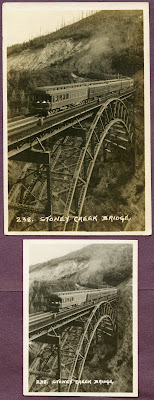You are looking at what was the tallest bridge in the world at the time this picture was taken. This is the Canadian Pacific Railway’s Stoney Creek Bridge, on the eastern side of Rogers Pass in the Selkirk Mountains of British Columbia, Canada.
It was built as part of the Continental Railroad promised to the citizens of British Columbia if they would vote to join the Canadian Federation. The present steel bridge is a 656 foot long truss arch bridge. In 1893 this bridge replaced a wooden trestle that was built in 1885. It stands 295 feet over Stoney Creek. In 1929 a second steel arch was added to handle the train traffic that had become heavier over the decades.
For almost 60 years, until 1988, this bridge handled all of the Canadian Pacific's transcontinental traffic. A second track was built at a lower altitude, so that now this bridge is designated to handle mostly eastbound rail traffic. The "Rocky Mountaineer" and the "Royal Canadian Pacific" tourist trains usually cross this bridge.
It was a great image for rail fan photographers for decades. However, some “graffiti artists” decided to decorate the bridge and vandalize the radio relay tower nearby. Fortunately, the relay tower was alarmed and they were caught. Unfortunately, because of its remoteness, rail fans are not welcomed and the engineers are asked to radio in any leads about any trespassers. One of my dreams that will not be fulfilled!
These two “real photo” post cards are the same image taken by the same photographer: Byron Harmon. He simply produced the image in two renderings. I know it is Byron Harmon because he has stamped the back of the larger post card with his well-known and trademarked stamp.
Harmon arrived in Alberta in 1903 as an itinerant photographer after leaving his portrait studio in Tacoma, Washington. By 1906 He had become a founding member and official photographer of the Alpine Club of Canada. He took over 6,400 photographs while exploring the Canadian Rockies and the Selkirks, where the picture on this post card was taken. In 1907 Harmon began turning many of these photographs into real photo postcards, which became his principal life’s work. In 1924 he traveled into the Rockies with the photographer Lewis R. Freeman. Some of the real photo postcards produced under Harmon’s name from this trip may actually be the work of Freeman that he published for him. After this trip Harmon mostly produced scenes alongside railway lines.


No comments:
Post a Comment
If you know anything about the history of the cards, the trains or the locations, please add them.